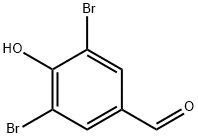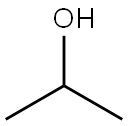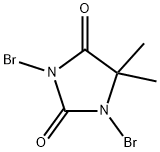1,3-Dibromo-2-propanol
- CAS NO.:96-21-9
- Empirical Formula: C3H6Br2O
- Molecular Weight: 217.89
- MDL number: MFCD00000216
- EINECS: 202-489-8
- SAFETY DATA SHEET (SDS)
- Update Date: 2024-12-18 14:08:57

What is 1,3-Dibromo-2-propanol?
Chemical properties
clear colorless to light yellow liquid
The Uses of 1,3-Dibromo-2-propanol
1,3-Dibromo-2-propanol may be used in the following studies:
- To prepare the thioether ligand, used in the synthesis of palladium-phosphorus/sulfur nanoparticles.
- Preparation of 2-(alkoxy)propenyl bromide.
- Synthesis of 1,3-propanediamine derivatives connected to carbohydrates (sugar-pendant diamines).
- Chemical crosslinking of nine single substitution cysteine mutants of staphylococcal nuclease.
- Preparation of 1,3-dinitrooxy-2-propanol, via reaction with AgNO3 in MeCN at 80°C.
What are the applications of Application
1,3-Dibromo-2-propanol is a dihalogenated alcoholl that is reported as bifunctional crosslinking reagent
General Description
1,3-Dibromo-2-propanol is a dihalogenated alcohol. It is reported as bifunctional crosslinking reagent.
Properties of 1,3-Dibromo-2-propanol
| Melting point: | 103-106 °C |
| Boiling point: | 82-83 °C/7 mmHg (lit.) |
| Density | 2.136 g/mL at 25 °C (lit.) |
| refractive index | n |
| Flash point: | 116 °F |
| storage temp. | Keep in dark place,Inert atmosphere,2-8°C |
| form | Liquid |
| pka | 12.46±0.20(Predicted) |
| color | Clear colorless to light yellow or light brown |
| Water Solubility | soluble |
| CAS DataBase Reference | 96-21-9(CAS DataBase Reference) |
| NIST Chemistry Reference | 2-Propanol, 1,3-dibromo-(96-21-9) |
| EPA Substance Registry System | 2-Propanol, 1,3-dibromo- (96-21-9) |
Safety information for 1,3-Dibromo-2-propanol
| Signal word | Danger |
| Pictogram(s) |
 Flame Flammables GHS02  Skull and Crossbones Acute Toxicity GHS06  Health Hazard GHS08 |
| GHS Hazard Statements |
H226:Flammable liquids H301:Acute toxicity,oral H315:Skin corrosion/irritation H319:Serious eye damage/eye irritation H335:Specific target organ toxicity, single exposure;Respiratory tract irritation H351:Carcinogenicity |
| Precautionary Statement Codes |
P201:Obtain special instructions before use. P210:Keep away from heat/sparks/open flames/hot surfaces. — No smoking. P302+P352:IF ON SKIN: wash with plenty of soap and water. P305+P351+P338:IF IN EYES: Rinse cautiously with water for several minutes. Remove contact lenses, if present and easy to do. Continuerinsing. |
Computed Descriptors for 1,3-Dibromo-2-propanol
| InChIKey | KIHQZLPHVZKELA-UHFFFAOYSA-N |
1,3-Dibromo-2-propanol manufacturer
Faluck International
1Y
Phone:+91-9825549375
Whatsapp: +91 9825549375
product: 96-21-9 1,3-Dibromopropan-2-ol 98%
New Products
Tert-butyl bis(2-chloroethyl)carbamate 4-Methylphenylacetic acid N-Boc-D-alaninol N-BOC-D/L-ALANINOL 3-Morpholino-1-(4-nitrophenyl)-5,6-dihydropyridin- 2(1H)-one Furan-2,5-Dicarboxylic Acid Tropic acid 1,1’-CARBONYLDIIMIDAZOLE DIETHYL AMINOMALONATE HYDROCHLORIDE R-2-BENZYLOXY PROPIONIC ACID 1,1’-CARBONYLDI (1,2-4 TRIAZOLE) N-METHYL INDAZOLE-3-CARBOXYLIC ACID (2-Hydroxyphenyl)acetonitrile 4-Bromopyrazole 5-BROMO-2CYANO PYRIDINE 5,6-Dimethoxyindanone 5-broMo-2-chloro-N-cyclopentylpyriMidin-4-aMine 2-(Cyanocyclohexyl)acetic acid 4-methoxy-3,5-dinitropyridine 2-aminopropyl benzoate hydrochloride 1-(4-(aminomethyl)benzyl)urea hydrochloride diethyl 2-(2-((tertbutoxycarbonyl)amino) ethyl)malonate tert-butyl 4- (ureidomethyl)benzylcarbamate Ethyl-2-chloro((4-methoxyphenyl)hydrazono)acetateRelated products of tetrahydrofuran








You may like
-
 96-21-9 1,3-Dibromopropan-2-ol 98%View Details
96-21-9 1,3-Dibromopropan-2-ol 98%View Details
96-21-9 -
 1,3-Dibromo-2-propanol (stabilized with Copper chip) CAS 96-21-9View Details
1,3-Dibromo-2-propanol (stabilized with Copper chip) CAS 96-21-9View Details
96-21-9 -
 1975-50-4 98%View Details
1975-50-4 98%View Details
1975-50-4 -
 2-HYDROXY BENZYL ALCOHOL 98%View Details
2-HYDROXY BENZYL ALCOHOL 98%View Details
90-01-7 -
 2-Chloro-1,3-Bis(Dimethylamino)Trimethinium Hexafluorophosphate 221615-75-4 98%View Details
2-Chloro-1,3-Bis(Dimethylamino)Trimethinium Hexafluorophosphate 221615-75-4 98%View Details
221615-75-4 -
 14714-50-2 (2-Hydroxyphenyl)acetonitrile 98+View Details
14714-50-2 (2-Hydroxyphenyl)acetonitrile 98+View Details
14714-50-2 -
 118753-70-1 98+View Details
118753-70-1 98+View Details
118753-70-1 -
 733039-20-8 5-broMo-2-chloro-N-cyclopentylpyriMidin-4-aMine 98+View Details
733039-20-8 5-broMo-2-chloro-N-cyclopentylpyriMidin-4-aMine 98+View Details
733039-20-8
Statement: All products displayed on this website are only used for non medical purposes such as industrial applications or scientific research, and cannot be used for clinical diagnosis or treatment of humans or animals. They are not medicinal or edible.